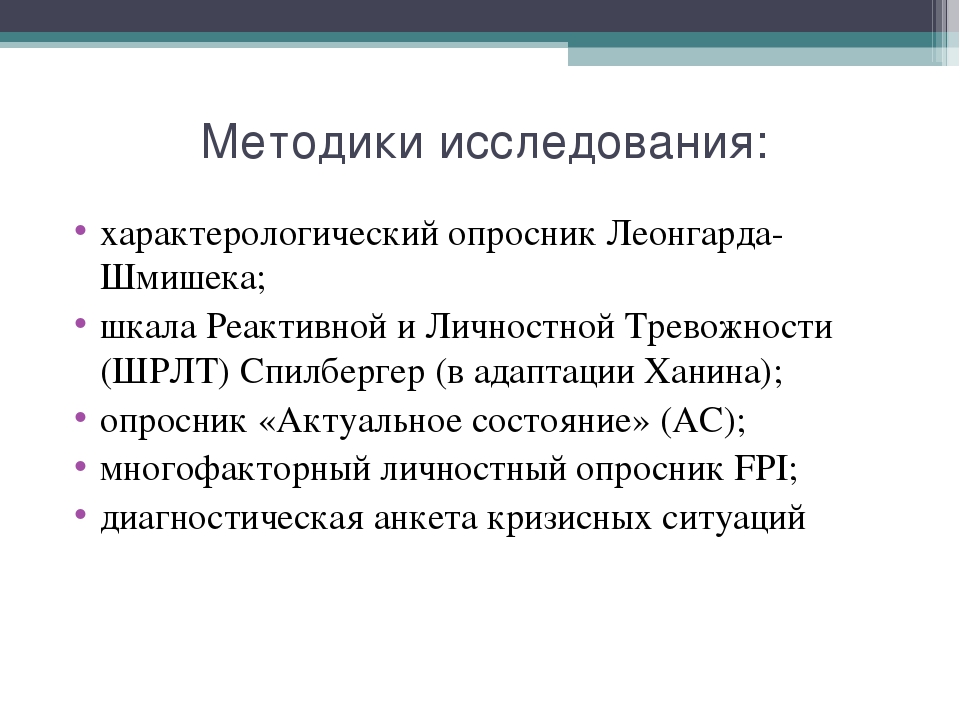Расширенный тест леонгарда шмишека: Опросник Шмишека (акцентуации характера) — Пройти онлайн тест
Эмоциональноличностные особенности пациентов с доброкачественным пароксизмальным позиционным головокружением и их влияние на развитие функционального головокружения | Макаров
1. Strupp M., Feil K., Zwergal A. Diagnosis and Differential Diagnosis of Peripheral and Central Vestibular Disorders. Laryngorhinootologie. 2021; 100 (3): 176–83.
2. Biswas A., Dutta N. Post-BPPV Syndrome: Our Experience in a Specialized Neurotology Clinic in Kolkata. Ann Otol Neurotol [Internet]. 2019 Mar 30; 02 (01): 01–9. Available from: http://www.thieme-connect.de/DOI/DOI?10.1055/s-0039–1695666
3. Yagi C., Morita Y., Kitazawa M., Nonomura Y., Yamagishi T., Ohshima S., et al. A Validated Questionnaire to Assess the Severity of Persistent Postural-Perceptual Dizziness (PPPD). Otol Neurotol [Internet]. 2019 Aug; 40 (7): e747–52. Available from: http://insights.ovid.com/crossref?an=00129492–201908000–00028
4. López-Gentili L.I., Kremenchutzky M., Salgado P. [A statistical analysis of 1300 patients with dizziness-vertigo. Its most frequent causes]. Rev Neurol [Internet]. 36 (5): 417–20. Available from: http://www.ncbi.nlm.nih.gov/pubmed/12640592
Its most frequent causes]. Rev Neurol [Internet]. 36 (5): 417–20. Available from: http://www.ncbi.nlm.nih.gov/pubmed/12640592
5. Ferrari S., Monzani D., Baraldi S., Simoni E., Prati G., Forghieri M., et al. Vertigo ‘in the pink’: The impact of female gender on psychiatric-psychosomatic comorbidity in benign paroxysmal positional vertigo patients. Psychosomatics [Internet]. 55 (3): 280–8. Available from: http://www.ncbi.nlm.nih.gov/pubmed/23756120
6. Monzani D., Genovese E., Rovatti V., Malagoli M.L., Rigatelli M., Guidetti G. Life events and benign paroxysmal positional vertigo: a case-controlled study. Acta Otolaryngol [Internet]. 2006 Sep; 126 (9): 987–92. Available from: http://www.ncbi.nlm.nih.gov/pubmed/16864499
7. Habs M., Strobl R., Grill E., Dieterich M., Becker-Bense S. Primary or secondary chronic functional dizziness: does it make a difference? A DizzyReg study in 356 patients. J Neurol [Internet]. 2020; (0123456789). Available from: https://doi.org/10.1007/s00415–020–10150–9
8.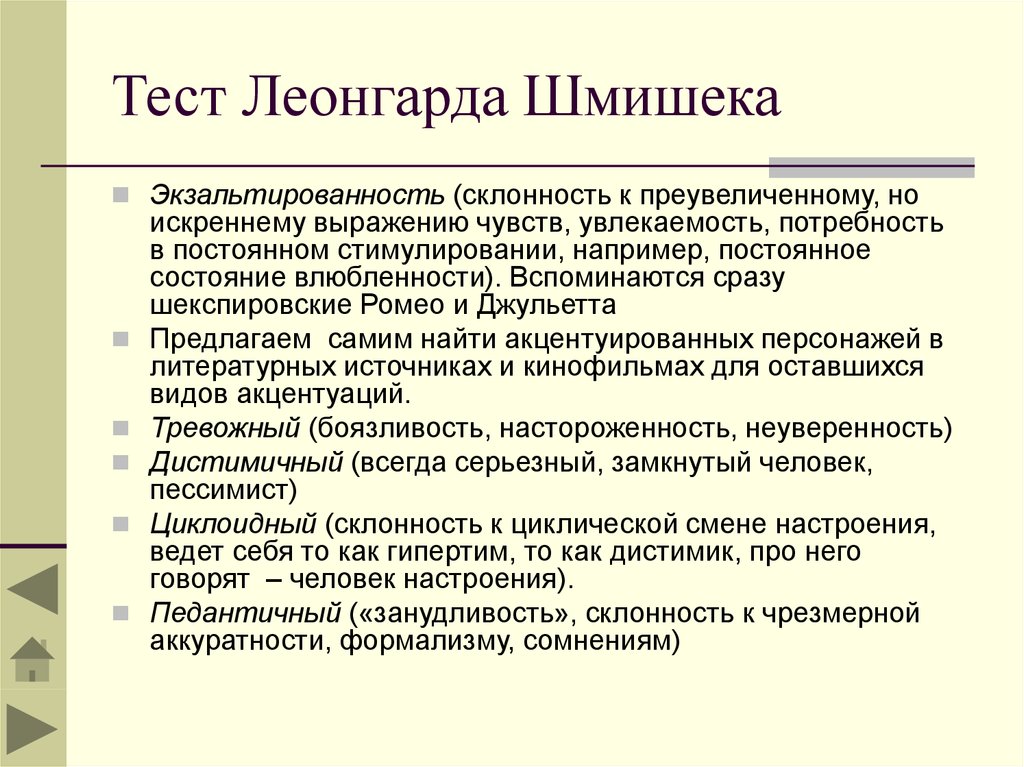 Heinrichs N., Edler C., Eskens S., Mielczarek M.M., Moschner C. Predicting Continued Dizziness After an Acute Peripheral Vestibular Disorder. Psychosom Med [Internet]. 2007 Sep; 69 (7): 700–7. Available from: http://journals.lww.com/00006842–200709000–00015
Heinrichs N., Edler C., Eskens S., Mielczarek M.M., Moschner C. Predicting Continued Dizziness After an Acute Peripheral Vestibular Disorder. Psychosom Med [Internet]. 2007 Sep; 69 (7): 700–7. Available from: http://journals.lww.com/00006842–200709000–00015
9. Дюкова Г.М., Замерград М.В. Вестибулярная паника. Медицинский алфавит. 2015; 2 (19): 12–6.
10. Иванова Т.А., Филатова Е.Г. Психогенное головокружение при мигрени. Медицинский алфавит. 2017; 3 (32): 5–12.
11. Eckhardt-Henn A. Psychosomatische Schwindelerkrankungen. HNO [Internet]. 2013 Sep 3; 61 (9): 777–80. Available from: http://link.springer.com/10.1007/s00106–013–2744-x
12. Dieterich M., Staab J.P. Functional dizziness: From phobic postural vertigo and chronic subjective dizziness to persistent postural-perceptual dizziness. Vol. 30, Current Opinion in Neurology. 2017.
13. Teggi R., Quaglieri S., Gatti O., Benazzo M., Bussi M. Residual Dizziness after Successful Repositioning Maneuvers for Idiopathic Benign Paroxysmal Positional Vertigo.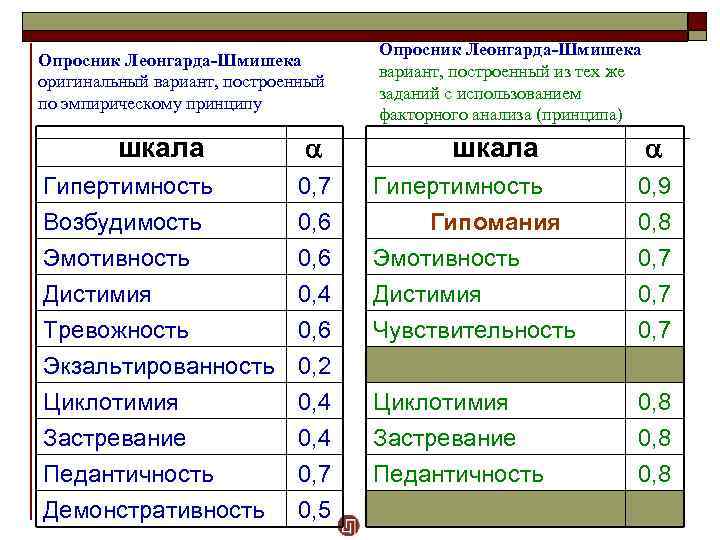 ORL [Internet]. 2013; 75 (2): 74–81. Available from: https://www.karger.com/Article/FullText/350255
ORL [Internet]. 2013; 75 (2): 74–81. Available from: https://www.karger.com/Article/FullText/350255
14. Faralli M., Ricci G., Ibba M.C., Crognoletti M., Longari F., Frenguelli A. Dizziness in patients with recent episodes of benign paroxysmal positional vertigo: real otolithic dysfunction or mental stress? J Otolaryngol Head Neck Surg [Internet]. 2009 Jun; 38 (3): 375–80. Available from: http://www.ncbi.nlm.nih.gov/pubmed/19476771
15. Dros J., Maarsingh O.R., Beem L., van der Horst H.E., Riet G. ter, Schellevis F.G., et al. Functional Prognosis of Dizziness in Older Adults in Primary Care: A Prospective Cohort Study. J Am Geriatr Soc [Internet]. 2012 Dec; 60 (12): 2263–9. Available from: https://onlinelibrary.wiley.com/doi/10.1111/jgs.12031
16. Bittar R.S.M., von Söhsten Lins E.M.D. Clinical characteristics of patients with persistent postural-perceptual dizziness. Braz J Otorhinolaryngol [Internet]. 2015 May; 81 (3): 276–82. Available from: https://linkinghub.elsevier.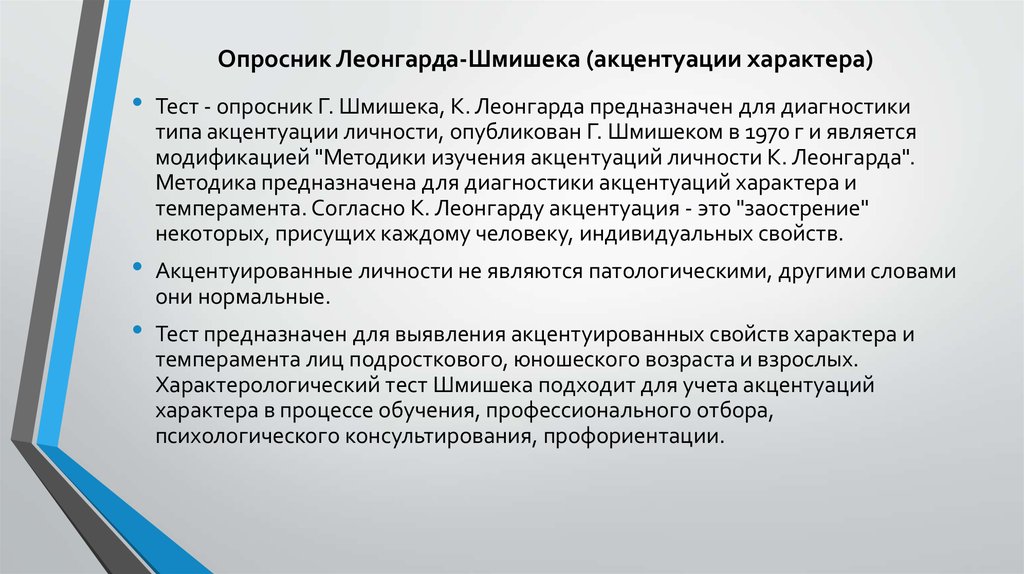 com/retrieve/pii/S1808869414001128
com/retrieve/pii/S1808869414001128
17. Martellucci S., Pagliuca G., De Vincentiis M., Greco A., De Virgilio A., Nobili Benedetti F.M., et al. Features of Residual Dizziness after Canalith Repositioning Procedures for Benign Paroxysmal Positional Vertigo. Otolaryngol Neck Surg [Internet]. 2016 Apr 9; 154 (4): 693–701. Available from: http://journals.sagepub.com/doi/10.1177/0194599815627624
18. Dyukova G.M., Kryukov A.I., Makarov S.A., Guseva A.L., Olimpieva S.P. A method for prediction functional dizziness after benign paroxysmal positional vertigo. Zhurnal Nevrol i psikhiatrii im SS Korsakova [Internet]. 2021; 121 (5): 120. Available from: http://www.mediasphera.ru/issues/zhurnal-nevrologii-i-psikhiatrii-im-s-s-korsakova/2021/5/1199772982021051120
19. Зайцева О.В., Дайхес Н. А., Лиленко С. В., Свистушкин В. М., Морозова С. В. КИМ. Головокружение (периферическое). Клинические рекомендации. Национальная медицинская ассоциация оториноларингологов. Москва. 2016.
20. Staab J. P., Eckhardt-Henn A., Horii A., Jacob R., Strupp M., Brandt T., et al. Diagnostic criteria for persistent postural-perceptual dizziness (PPPD): Consensus document of the committee for the Classification of Vestibular Disorders of the Bárány Society. J Vestib Res [Internet]. 2017 Oct 21; 27 (4): 191–208. Available from: https://www.medra.org/servlet/aliasResolver?alias=iospress&doi=10.3233/VES-170622
P., Eckhardt-Henn A., Horii A., Jacob R., Strupp M., Brandt T., et al. Diagnostic criteria for persistent postural-perceptual dizziness (PPPD): Consensus document of the committee for the Classification of Vestibular Disorders of the Bárány Society. J Vestib Res [Internet]. 2017 Oct 21; 27 (4): 191–208. Available from: https://www.medra.org/servlet/aliasResolver?alias=iospress&doi=10.3233/VES-170622
21. Jacobson G.P., Newman C. W. The Development of the Dizziness Handicap Inventory. Arch Otolaryngol – Head Neck Surg [Internet]. 1990 Apr 1; 116 (4): 424–7. Available from: http://archotol.jamanetwork.com/article.aspx?articleid=618622
22. Spitzer R.L. Validation and utility of a self-report version of PRIME-MD: the PHQ primary care study. Primary Care Evaluation of Mental Disorders. Patient Health Questionnaire. JAMA [Internet]. 1999 Nov 10; 282 (18): 1737. Available from: http://jama.jamanetwork.com/article.aspx?doi=10.1001/jama.282.18.1737
23. Spitzer R.L., Kroenke K. , Williams J.B.W., Löwe B. A Brief Measure for Assessing Generalized Anxiety Disorder. Arch Intern Med [Internet]. 2006 May 22; 166 (10): 1092. Available from: http://archinte.jamanetwork.com/article.aspx?doi=10.1001/archinte.166.10.1092
, Williams J.B.W., Löwe B. A Brief Measure for Assessing Generalized Anxiety Disorder. Arch Intern Med [Internet]. 2006 May 22; 166 (10): 1092. Available from: http://archinte.jamanetwork.com/article.aspx?doi=10.1001/archinte.166.10.1092
24. Kroenke K., Spitzer R.L., Williams J.B.W. The PHQ-15: Validity of a New Measure for Evaluating the Severity of Somatic Symptoms. Psychosom Med [Internet]. 2002 Mar; 64 (2): 258–66. Available from: http://journals.lww.com/00006842–200203000–00008
25. Holmes T.H., Rahe R. H. The social readjustment rating scale. J Psychosom Res [Inter-net]. 1967 Aug; 11 (2): 213–8. Available from: https://linkinghub.elsevier.com/retrieve/pii/0022399967900104
26. Beljaew W.N. Die Bedeutung von ‘Akzentuierungen’ in der Diagnostik praktischer Medizin [Importance of ‘accentuation’ for diagnostics in practical medicine]. Psychiatr Neurol Med Psychol (Leipz). 1979 Jun; 31 (6): 329–34. German. PMID: 542540.
27. Reiss S., Peterson R.A., Gursky D.M., McNally R.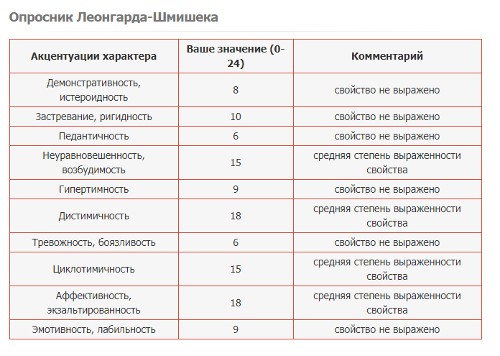 J. Anxiety sensitivity, anxiety frequency and the prediction of fearfulness. Behav Res Ther [Internet]. 1986; 24 (1): 1–8. Available from: https://linkinghub.elsevier.com/retrieve/pii/0005796786901439
J. Anxiety sensitivity, anxiety frequency and the prediction of fearfulness. Behav Res Ther [Internet]. 1986; 24 (1): 1–8. Available from: https://linkinghub.elsevier.com/retrieve/pii/0005796786901439
28. Hoffart A., Friis S., Martinsen E.W. Assessment of fear of fear among Agoraphobic patients: The Agoraphobic Cognitions Scale. J Psychopathol Behav Assess [Internet]. 1992 Jun; 14 (2): 175–87. Available from: http://link.springer.com/10.1007/BF00965173
29. Diukova G.M., Zamergrad M. V., Golubev V. L., Adilova S. M., Makarov S. A. Functional (psychogenic) vertigo. Zhurnal Nevrol i psikhiatrii Im SS Korsakova [Internet]. 2017; 117 (6): 91. Available from: http://www.mediasphera.ru/issues/zhurnal-nevrologii-i-psikhiatrii-im-s-s-korsakova/2017/6/downloads/ru/1199772982017061091
30. Wang L., Zhou H.F., Wang M.X., Zhang J., Su J., Guo Y. [Comparison of anxiety and depression state among patients with different type of benign paroxysmal positional vertigo]. Lin Chung Er Bi Yan Hou Tou Jing Wai Ke Za Zhi [Internet]. 2016 Nov 5; 30 (21): 1710–3. Available from: http://www.ncbi.nlm.nih.gov/pubmed/29871180
2016 Nov 5; 30 (21): 1710–3. Available from: http://www.ncbi.nlm.nih.gov/pubmed/29871180
31. Limburg K., Schmid-Mühlbauer G., Sattel H., Dinkel A., Radziej K., Gonzales M., et al. Potential effects of multimodal psychosomatic inpatient treatment for patients with functional vertigo and dizziness symptoms – A pilot trial. Psychol Psychother Theory, Res Pract [Internet]. 2019 Mar; 92 (1): 57–73. Available from: https://onlinelibrary.wiley.com/doi/10.1111/papt.12177
32. Piker E.G., Jacobson G.P., McCaslin D.L., Grantham S.L. Psychological Comorbidities and Their Relationship to Self-Reported Handicap in Samples of Dizzy Patients. J Am Acad Audiol [Internet]. 2008 Apr 6; 19 (04): 337–47. Available from: http://www.thieme-connect.de/DOI/DOI?10.3766/jaaa.19.4.6
33. Eckhardt A., Tettenborn B., Krauthauser H., Thomalske C., Hartmann O., Hoffmann S.O., et al. Schwindel- und Angsterkrankungen – Ergebnisse einer interdisziplinären Untersuchung. Laryngo-Rhino-Otologie [Internet]. 1996 Sep 29; 75 (09): 517–22. Available from: http://www.thieme-connect.de/DOI/DOI?10.1055/s-2007–997625
1996 Sep 29; 75 (09): 517–22. Available from: http://www.thieme-connect.de/DOI/DOI?10.1055/s-2007–997625
34. Best C., Eckhardt-Herrn A., Diener G., Bense S., Breuer P., Dieterich M. Interaction of somatoform and vestibular disorders. J Neurol Neurosurg Psychiatry. 2006; 77 (5): 658–64.
35. Best C., Tschan R., Eckhardt-Henn A., Dieterich M. Who is at risk for ongoing dizziness and psychological strain after a vestibular disorder? Neuroscience [Internet]. 2009 Dec; 164 (4): 1579–87. Available from: https://linkinghub.elsevier.com/retrieve/pii/S0306452209015097
36. Cousins S., Kaski D., Cutfield N., Arshad Q., Ahmad H., Gresty M.A., et al. Predictors of clinical recovery from vestibular neuritis: a prospective study. Ann Clin Transl Neurol [Internet]. 2017 May; 4 (5): 340–6. Available from: http://doi.wiley.com/10.1002/acn3.386
37. Kahraman S.S., Arli C., Copoglu U.S., Kokacya M.H., Colak S. The evaluation of anxiety and panic agarophobia scores in patients with benign paroxysmal positional vertigo on initial presentation and at the follow-up visit. Acta Otolaryngol. 2017; 137 (5).
Acta Otolaryngol. 2017; 137 (5).
38. Staab J.P., Rohe D.E., Eggers S.D.Z., Shepard N.T. Anxious, introverted personality traits in patients with chronic subjective dizziness. J Psychosom Res [Internet]. 2014; 76 (1): 80–3. Available from: http://dx.doi.org/10.1016/j.jpsychores.2013.11.008
39. Indovina I., Riccelli R., Staab J.P., Lacquaniti F., Passamonti L. Personality traits modulate subcortical and cortical vestibular and anxiety responses to sound-evoked otolithic receptor stimulation. J Psychosom Res [Internet]. 2014; 77 (5): 391–400. Available from: http://dx.doi.org/10.1016/j.jpsychores.2014.09.005
40. Powell G., Derry-Sumner H., Rajenderkumar D., Rushton S.K., Sumner P. Persistent postural perceptual dizziness is on a spectrum in the general population. Neurology. 2020 May 5; 94 (18): e1929–38.
41. Lopez-Gonzalez M.A., Cherta G., Nieto J.A., Esteban F. Otology versus Otosociology. ISRN Otolaryngol. 2012; 2012: 1–10.
42. Lacour M., Bernard-Demanze L. Interaction between vestibular compensation mechanisms and vestibular rehabilitation therapy: 10 recommendations for optimal functional recovery. Front Neurol. 2015; 5 (January): 1–14.
Interaction between vestibular compensation mechanisms and vestibular rehabilitation therapy: 10 recommendations for optimal functional recovery. Front Neurol. 2015; 5 (January): 1–14.
Ключ к опроснику Леонгарда-Шмишека
Акцентуированные черты личности характеризуются ответами «Да» или «Нет» на следующие вопросы.
1 | Гипертимность | 1, 11, 23, 33, 45, 56, 67, 77 – Да. Сумму ответов совпавших с ключом «Да» умножить на 3. |
2 | Застревание | 2, 15, 24, 37, 55, 68, 78, 81 – Да. 12, 46, 59 – Нет. Сумму ответов совпавших с ключом «Да» и «Нет» умножить на 2. |
3 | Эмотивность | 3,
13, 35, 47, 57, 69, 79 – Да. 25 – Нет. Сумму ответов совпавших с ключом «Да» и «Нет» умножить на 3. |
4 | Педантичность | 4,14, 17, 26, 39,47, 58, 61,70, 80, 83 – Да. 36 – Нет. Сумму ответов совпавших с ключом «Да» и «Нет» умножить на 2. |
5 | Тревожность | 16, 27, 38,49, 60, 71, 82 – Да. 5 – Нет. Сумму ответов совпавших с ключом «Да» и «Нет» умножить на 3. |
6 | Циклотимность | 6, 18, 28, 40, 50, 62, 72, 84 – Да. Сумму ответов совпавших с ключом. «Да» умножить на 3. |
7 | Демонстративность | 7, 19, 22, 29, 41,
44, 63, 66, 73, 85, 88 – Да. 51 – Нет. Сумму ответов совпавших с ключом «Да» и «Нет» умножить на 2. |
8 | Возбудимость | 8, 20, 30, 42, 52, 64, 74, 86 – Да. Сумму ответов совпавших с ключом «Да» умножить на 3. |
9 | Дистимичность | 9, 21,43,75, 87 – Да. 31, 53, 65 – Нет. Сумму ответов совпавших с ключом «Да» и «Нет» умножить на 3. |
10 | Экзальтированность | 10, 32, 54, 76 – Да. Сумму ответов совпавших с ключом «Да» умножить на 6. |
Максимальная сумма
баллов после
умножения – 24.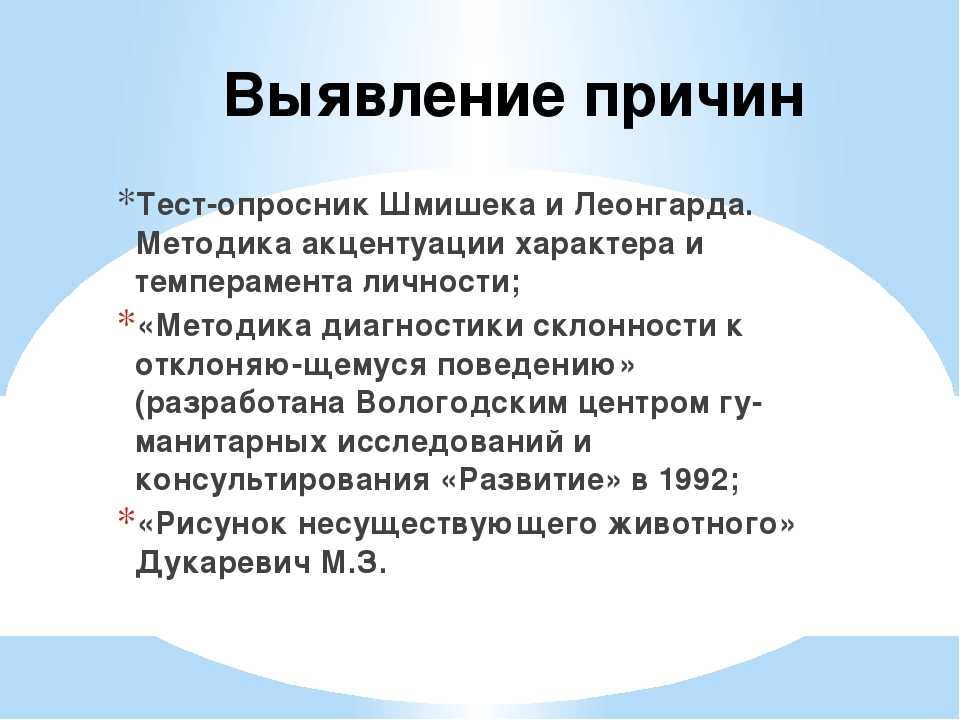 Черта характера
является акцентуированной, если сумма
баллов равна
или больше 19.
Если акцентуированной является одна
черта, то тип характера определяется в
первую очередь по ней. Если акцентуированы
несколько черт, то тип определяется по
всем ним с учетом максимумов.
Черта характера
является акцентуированной, если сумма
баллов равна
или больше 19.
Если акцентуированной является одна
черта, то тип характера определяется в
первую очередь по ней. Если акцентуированы
несколько черт, то тип определяется по
всем ним с учетом максимумов.
Четыре-пять повышений до уровня акцентуированности в профиле могут означать наличие состояния психического стресса.
Если в профиле нет заостренных черт, то, следовательно, у обследуемого нет выраженного типа характера и можно говорить о тенденциях к тому или иному типу. О тенденции судим в случае, если конечная сумма баллов по черте находится в диапазоне от 15 до 19.
От 1 до 10 – черта характера.
Профиль характера по Леонгарду-Шмишеку
Сумма баллов (после умножения по черте характера) | Характеристика |
От 1 до 19 | Диапазон тенденций к тому или иному типу характера |
От 20 до 24 | Диапазон акцентуированных черт и типов характера |
К.



